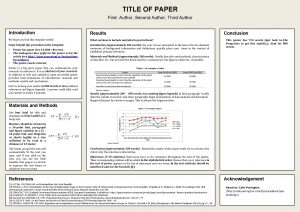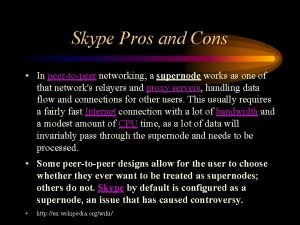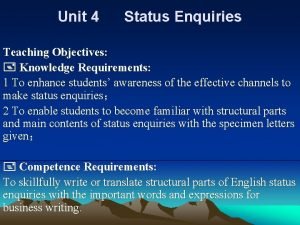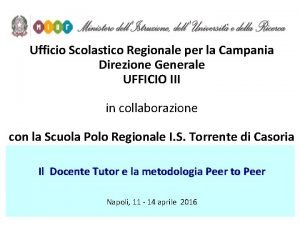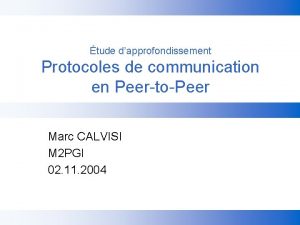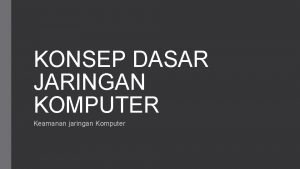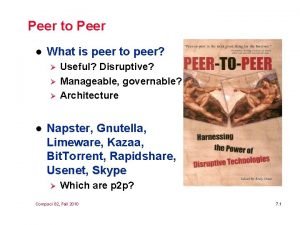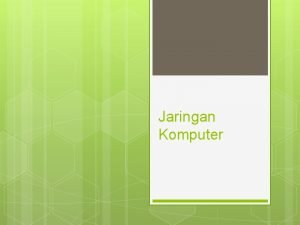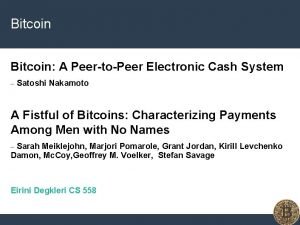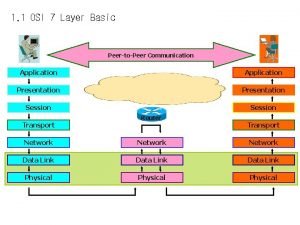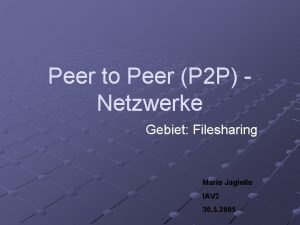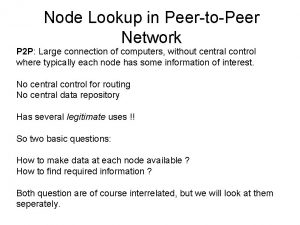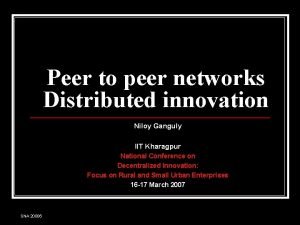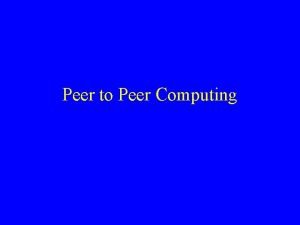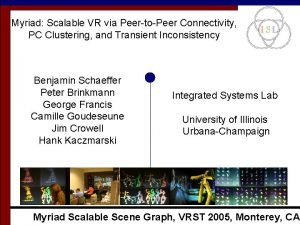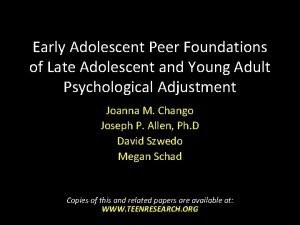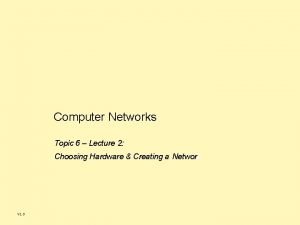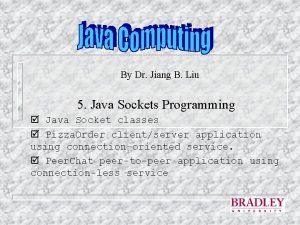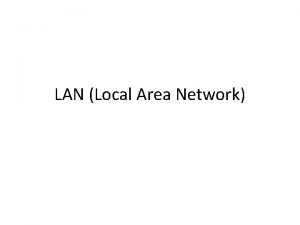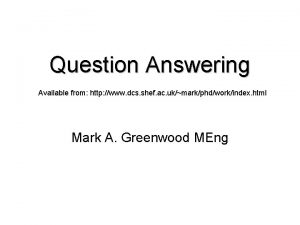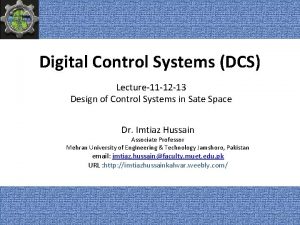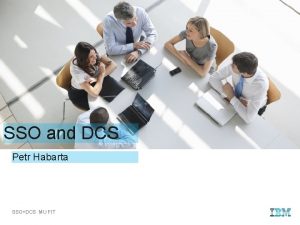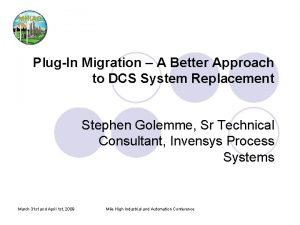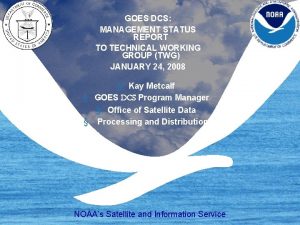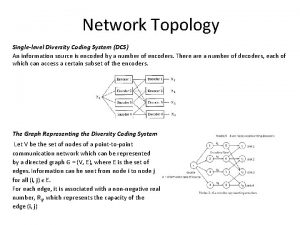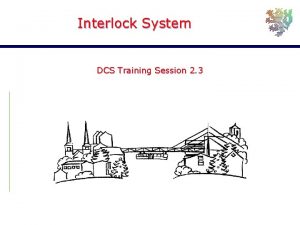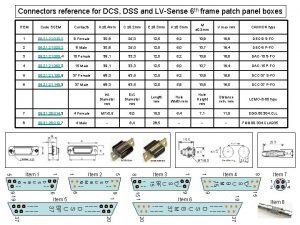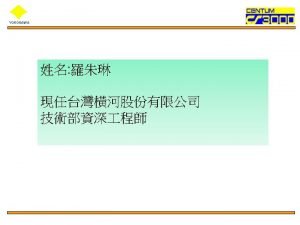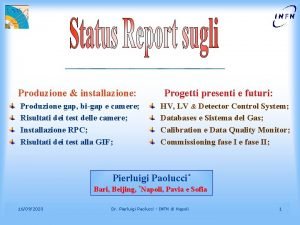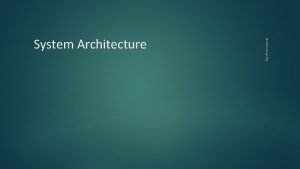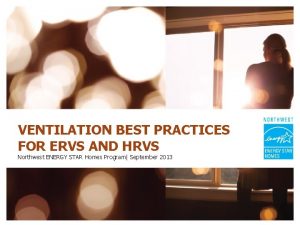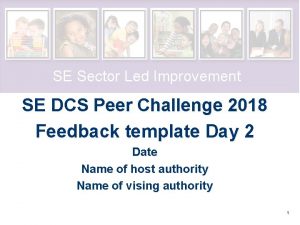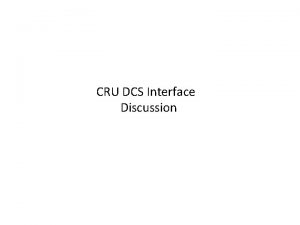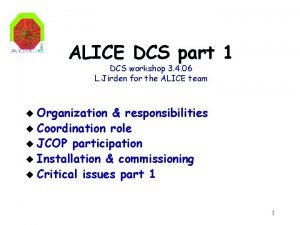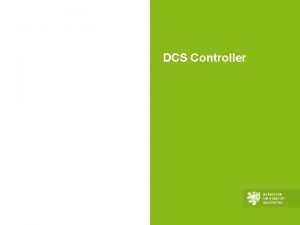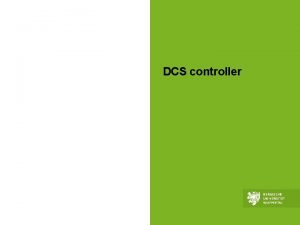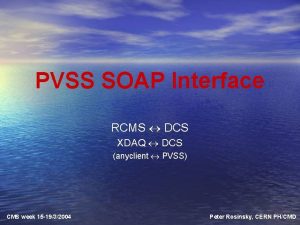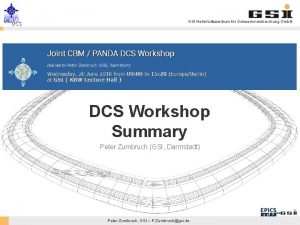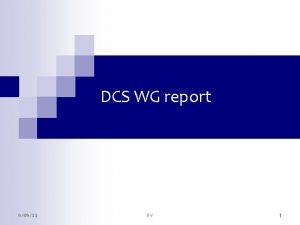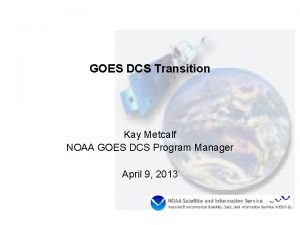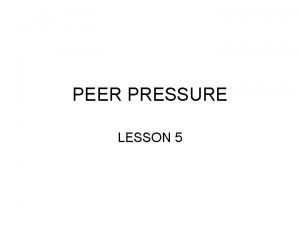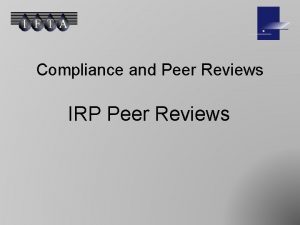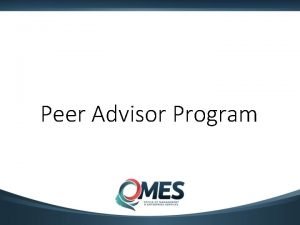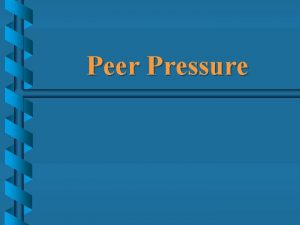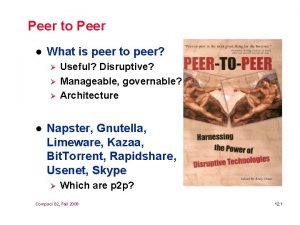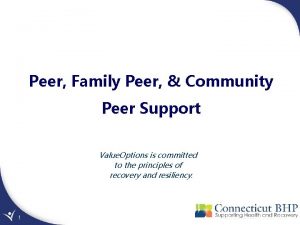SE DCS peer challenge Author and further enquiries























































- Slides: 55

SE DCS peer challenge Author and further enquiries to annawright@me. com

• Your name and role What are the enablers to • Your prior experience of making this process work peer challenge well, and what are the • One question you’d like to barriers? answer this morning

Aims and Objectives ● To understand the purpose of the new SE peer challenge, and the new process being used for the peer challenge days ● To be aware of the factors that make peer challenge more rigorous and effective and those that diminish its impact ● To understand the process and tools provided so that all teams are familiar with it and can use them to help each authority get insights and perspectives into its strengths and risks in a way that enables improvement ● To consider what action needs to be taken before, during and after the days to get the most out of the process

Sector led improvement regional alliances ● Serve as the primary means by which the sector will address the early identification of concerns before they reach crisis point; ● Build and share best practice; ● Contribute to an evidenced based model for improvement; ● Create the conditions for a learning system which unites all stakeholders from regulation to delivery in a robust and collective approach to improvement.

Building system resilience ● To enable members of a community to connect and use community resources to thrive in a changing and precarious environment ● a resilient community is ‘‘one that takes intentional action to enhance the personal and collective capacity of its institutions and citizens to respond to and influence the course of social and economic change. ” Canadian Centre for Community Renewal. (2000) The community resilience manual. A resource for rural recovery and renewal. Port Alberni, Canada: Centre for Community Enterprise at link

SE peer challenge the process

The new peer challenge process ● Each authority will produce a self-assessment, signed off by the DCS, during the autumn – dates agreed with each triad in advance ● SESLIP optionally reviews the draft Ofsted self-assessment – looking at the data, strengths, whethere is a holistic picture and window on practice ● Hold peer challenge days in January and February. The days will be 3 x 2 -hour challenge sessions with breaks and a wrap-up session. ● The days will be attended by the 3 x DCS and up to 3 members of their team they wish to bring ● SESLIP is providing a facilitator who will also collect and write up examples of best practice/common systemic issues that need to be addressed. ● The aims of the sessions are to produce insights, offers and asks ● A summit meeting in the Spring to share and celebrate best practice, highlight the common issues that may require collective action discuss any next steps and approve the SESLIP improvement plan and support for the following year.

Optional review of self assessment by SESLIP team will explore: ● To what extent has the SA highlighted strengths, with evidence of impact as well as activity ● Is there any discrepancy between data and conclusions? ● Can the LA show it is able to identify caseload issues ● Does the SA tell a holistic story, or does it describe silo’d information? ● Does it address key issues picked up in previous Ofsted reports?

Desired output from peer challenge days ● Key strengths of each LA which can be offers to others in the SE and be written up as case studies for wider circulation ● Insights on any systemic issues or signatures of risk as a result of feedback from colleagues ● Key asks that might be made of others in the region to support each local authority’s improvement journey

Understanding the data

Peer challenge data tool Aims: ● A single sheet where as much data as possible is pulled in to one place and shows relative performance ● A tool that allows LAs to compare their performance with the SE, England a selected LA. ● Based on the most up to date quarterly and annual data (We’ll be using this when reviewing the self evaluations)

Making the process work well

The purpose 1. Are the self-assessments taking into account all possible signatures of risk? 2. What excellent practice should be shared more widely? and 3. Where people are experiencing significant challenges, how can others help?

What are the enablers to making this process work well, and what are the barriers?

The values underpinning this process ● Mutual respect, openness and honesty ● Non-judgemental feedback ● The need to diagnose and understand why things are like they are ● A practical focus on how outcomes for young people could be improved

Power dynamics

@Patrick Quattlebaum Male Woman Other male

@Patrick Quattlebaum BIG Local Authority small Local Authorities

@Patrick Quattlebaum Outstanding Inadequate Requires improvement

Sharing knowledge @Patrick Quattlebaum

Supporting each other @Patrick Quattlebaum

Giving an insightful message @Patrick Quattlebaum

Attacking the presenter @Patrick Quattlebaum

Staying quiet. . . @Patrick Quattlebaum

@Patrick Quattlebaum Fighter Pleaser

Challenging Supporting @Patrick Quattlebaum

A little bit of neuroscience

The brain is deeply social Away threat Status Certainty Autonomy Relatedness Fairness Toward reward

Fight/flight video


What does epinephrine do? Normal flow of information Flow of information after stress Action part of brain Thinking brain Seeing brain

6 part emotion cycle Prompting event After effects How I interpret it Physical response Action Urge to act

6 part emotion: positive cycle Prompting event After effects SE DCS peer challenge Acting on learning, asking or offering support “I’m looking forward to seeing colleagues and learning together” Action I’m engaged, listening, thinking, learning, having insights, feeling empathy, seeing opportunities How I interpret it Physical response PSNS restorative system activated Urge to act “I feel calm, relaxed, curious, interested, sociable”

6 part emotion: when anxiety is present Prompting event After effects SE DCS peer challenge I feel more anxious, disheartened and disempowered as a possible threat, ‘they’ll find out I’m an imposter’ or ‘I need to show I’m good” Action I’m finding it difficult to listen, I don’t agree with them How I interpret it Physical response SNS triggered Urge to act I feel hot, not sure I want to be here, I can’t think straight, this is annoying

6 part emotion: Breaking the cycle t ra f Re Prompting event After effects SE DCS peer challenge I feel more anxious, disheartened and disempowered e puls m i t s i Res How I interpret it as a possible threat, ‘they’ll find out I’m an imposter’ or ‘I need to show I’m good” Action I’m finding it difficult to listen, I don’t agree with them i e m Physical response SNS triggered Urge to act I feel hot, not sure I want to be here, I can’t think straight, this is annoying Ca lm i ng

The process needs to enable ● the local authority presenting to get insights from the other two teams in a context that is safe and not confrontational and judgemental, ● a full exploration of signatures of risk, and the chance of developing insights which may help the authority with its improvement journey. ● the two other authority teams to be on the balcony during this process, asking powerful questions and sharing insights and possibilities as a result of being there, uncovering systemic rather than personal issues.

Listening for insights

1 Activity The presenter presents the self-assessment and identifies the signatures of risk they are most concerned about 15 mins 2 The group take it in turns to ask open questions to identify strengths and get a deeper perspective on the issues and consider other signatures of risk 1 hour 10 mins 4 The group gets on the balcony to discuss perspectives and offer insights on the self assessment, risks, key issues and ways forward 15 mins 5 The presenter reflects on what they have heard and says what they will do, including first thoughts on asks and offers 10 mins as a group and 10 mins as a response to the wider group 3 6 Each group member affirms the strengths they have observed 5 mins At the end of the day the facilitator draws out key learning points from the group

1 Activity The presenter presents the self-assessment and identifies the signatures of risk they are most concerned about 15 mins 2 The group take it in turns to ask open questions to identify strengths and get a deeper perspective on the issues and consider other signatures of risk 1 hour 10 mins 4 The group gets on the balcony to discuss perspectives and offer insights on the self assessment, risks, key issues and ways forward 15 mins 5 The presenter reflects on what they have heard and says what they will do, including first thoughts on asks and offers 10 mins as a group and 10 mins as a response to the wider group 3 6 Each group member affirms the strengths they have observed 5 mins At the end of the day the facilitator draws out key learning points from the group

Signatures of risk ● ● ● The broader political climate Corporate support Senior leadership turnover Service reorganisation Budget Performance Leading with others Workforce Learning culture Practice leadership External and internal challenge and feedback

1 Activity The presenter presents the self-assessment and identifies the signatures of risk they are most concerned about 15 mins 2 The group take it in turns to ask open questions to identify strengths and get a deeper perspective on the issues and consider other signatures of risk 1 hour 10 mins 4 The group gets on the balcony to discuss perspectives and offer insights on the self assessment, risks, key issues and ways forward 15 mins 5 The presenter reflects on what they have heard and says what they will do, including first thoughts on asks and offers 10 mins as a group and 10 mins as a response to the wider group 3 6 Each group member affirms the strengths they have observed 5 mins At the end of the day the facilitator draws out key learning points from the group

Examples of political climate questions ● If I was in your lead member’s shoes, what would I be saying about the pace of improvement in the service. What would I say about Cabinet support for children? What would I say the DCS needed to do differently? ● What would I be most concerned about? ● What do you think the Leader of the Council’s perspective on children is? How do you feel about this? What has been done to address it? How do you know if this action has had any impact? ● What is the current narrative about children’s services in the political realm? Is it the same or different from the corporate narrative? What is happening to address this? Will it work? ● What evidence is there of the impact of children’s and parent/carer’s voice on political decisions

Typical listening Sally starts talking, Bill listens Sally stops listening - starts developing response Bill stops listening starts developing response Bill starts talking, Sally listens

The power of listening “The ability to be present in such a way that the mind in front of us does its own thinking” - Nancy Klein

Enhanced listening ● ● ● We suppress extraneous thoughts We focus attention on the person speaking We listen from a place of kind intention We speak slowly and do not rush our questions We are full of curiosity about their world We breathe deeply as we listen so we make sure our restorative system is activated

Listener Presents issue and responds to questions Active listening and powerful questions Balcony Presenter Listening & observing What is happening? Is the listener effective in stimulating thinking?

1 Activity The presenter presents the self-assessment and identifies the signatures of risk they are most concerned about 15 mins 4 The group gets on the balcony to discuss perspectives and offer insights on the self assessment, risks, key issues and ways forward 15 mins 2 5 The group take it in turns to ask open questions to identify strengths and get a deeper perspective on the issues and consider other signatures of risk 1 hour 10 mins The presenter reflects on what they have heard and says what they will do, including first thoughts on asks and offers 10 mins as a group and 10 mins as a response to the wider group 3 6 Each group member affirms the strengths they have observed 5 mins At the end of the day the facilitator draws out key learning points from the group

1 Activity 4 The presenter presents the self-assessment and identifies the signatures of risk they are most concerned about 15 mins The group gets on the balcony to discuss perspectives and offer insights on the self assessment, risks, key issues and ways forward 15 mins 2 5 The group take it in turns to ask open questions to identify strengths and get a deeper perspective on the issues and consider other signatures of risk 1 hour 10 mins The presenter reflects on what they have heard and says what they will do, including first thoughts on asks and offers 10 mins as a group and 10 mins as a response to the wider group 3 6 Each group member affirms the strengths they have observed 5 mins At the end of the day the facilitator draws out key learning points from the group

Being on the balcony Listening Observing (verbal and non verbal) Reflecting Insights, new possibilities, options for support

Questions to ask from the balcony ● ● What are the basic assumptions behind the story being told here? ● What images or metaphors do the interviewees use? (Pay attention to the choice of words) ● ● ● What do the team judge as ‘good’ and ‘bad’? How do the senior leaders define their own role in the situation and that of others? Are the descriptions based on facts or interpretations? What assumptions are being made, do you think they are justified? Are both positive and negative aspects being highlighted? Are situations seen as static or dynamic?

1 Activity 4 The presenter presents the self-assessment and identifies the signatures of risk they are most concerned about 15 mins The group gets on the balcony to discuss perspectives and offer insights on the self assessment, risks, key issues and ways forward 15 mins 2 5 The group take it in turns to ask open questions to identify strengths and get a deeper perspective on the issues and consider other signatures of risk 1 hour 10 mins The presenter reflects on what they have heard and says what they will do, including first thoughts on asks and offers 10 mins as a group and 10 mins as a response to the wider group 3 6 Each group member affirms the strengths they have observed 5 mins At the end of the day the facilitator draws out key learning points from the group

1 Activity 4 The presenter presents the self-assessment and identifies the signatures of risk they are most concerned about 15 mins The group gets on the balcony to discuss perspectives and offer insights on the self assessment, risks, key issues and ways forward 15 mins 2 5 The group take it in turns to ask open questions to identify strengths and get a deeper perspective on the issues and consider other signatures of risk 1 hour 10 mins The presenter reflects on what they have heard and says what they will do, including first thoughts on asks and offers 10 mins as a group and 10 mins as a response to the wider group 3 6 Each group member affirms the strengths they have observed 5 mins At the end of the day the facilitator draws out key learning points from the group

What does each authority need to do before, during and after the peer challenge day to get the most learning out of this process?

Feedback and plenary

SE DCS peer challenge annawright@me. com
 First author second author third author
First author second author third author Features of peer to peer network and client server network
Features of peer to peer network and client server network Pros and cons of using skype
Pros and cons of using skype Replying inquiry letter
Replying inquiry letter Mail reply format
Mail reply format Get more enquiries
Get more enquiries Credit and status enquiries letter
Credit and status enquiries letter Enquiries and replies
Enquiries and replies Annotazioni sulla verifica effettuata peer to peer
Annotazioni sulla verifica effettuata peer to peer Peer-to-peer
Peer-to-peer Peer to peer transactional replication
Peer to peer transactional replication Peer to peer transactional replication
Peer to peer transactional replication Gambar topologi peer to peer
Gambar topologi peer to peer Esempio registro peer to peer compilato
Esempio registro peer to peer compilato Esempi di peer to peer compilati 2021
Esempi di peer to peer compilati 2021 Registro peer to peer compilato
Registro peer to peer compilato Peer to peer l
Peer to peer l Peer to peer merupakan jenis jaringan… *
Peer to peer merupakan jenis jaringan… * Bitcoin: a peer-to-peer electronic cash system
Bitcoin: a peer-to-peer electronic cash system Programmazione e sviluppo condiviso compilato
Programmazione e sviluppo condiviso compilato Peer-to-peer communication in osi model
Peer-to-peer communication in osi model Peer to peer vorteile nachteile
Peer to peer vorteile nachteile Node lookup in peer to peer network
Node lookup in peer to peer network Peer-to-peer o que é
Peer-to-peer o que é Peer to peer computing environment
Peer to peer computing environment Peer intervention program
Peer intervention program Peer-to-peer o que é
Peer-to-peer o que é Peer-to-peer o que é
Peer-to-peer o que é Peer to peer network hardware
Peer to peer network hardware Peer to peer chat application in java
Peer to peer chat application in java Jaringan peer to peer diistilahkan dengan
Jaringan peer to peer diistilahkan dengan Enquiry letter meaning
Enquiry letter meaning Replying to enquiries
Replying to enquiries Whitchester house
Whitchester house Dcs question and answer
Dcs question and answer Ezgo dcs troubleshooting
Ezgo dcs troubleshooting Feedback matrix examples
Feedback matrix examples Dcs 101
Dcs 101 Dcs system integrator
Dcs system integrator Dcs 550
Dcs 550 Nsd sso
Nsd sso Dcs migration strategy
Dcs migration strategy Dcs-5605
Dcs-5605 Dcs service providers
Dcs service providers Dcs management
Dcs management Dcs network topology
Dcs network topology L
L Dcs interlock
Dcs interlock Dcs
Dcs Fcs yokogawa
Fcs yokogawa Dcs 2,7
Dcs 2,7 Sistema di tenuta primaria dcs
Sistema di tenuta primaria dcs Dcs system architecture
Dcs system architecture Rh102am
Rh102am Dcs service providers
Dcs service providers Lifebreath 350 dcs
Lifebreath 350 dcs
